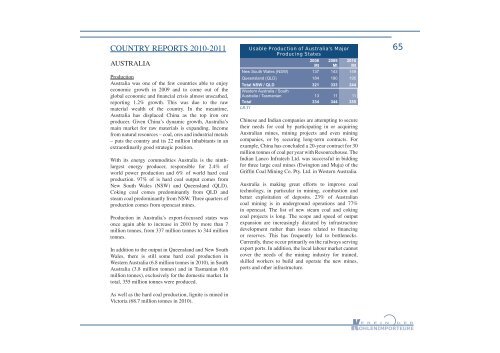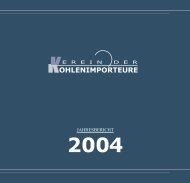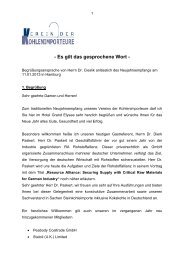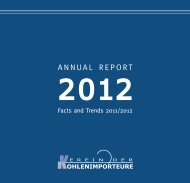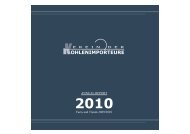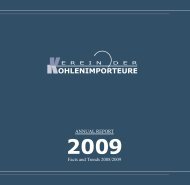Annual Report 2010 - Verein der Kohlenimporteure eV
Annual Report 2010 - Verein der Kohlenimporteure eV
Annual Report 2010 - Verein der Kohlenimporteure eV
You also want an ePaper? Increase the reach of your titles
YUMPU automatically turns print PDFs into web optimized ePapers that Google loves.
COUNTRY REPORTS <strong>2010</strong>-2011<br />
AUSTRALIA<br />
Production<br />
Australia was one of the few countries able to enjoy<br />
economic growth in 2009 and to come out of the<br />
global economic and financial crisis almost unscathed,<br />
reporting 1.2% growth. This was due to the raw<br />
material wealth of the country. In the meantime,<br />
Australia has displaced China as the top iron ore<br />
producer. Given China’s dynamic growth, Australia’s<br />
main market for raw materials is expanding. Income<br />
from natural resources – coal, ores and industrial metals<br />
– puts the country and its 22 million inhabitants in an<br />
extraordinarily good strategic position.<br />
With its energy commodities Australia is the ninthlargest<br />
energy producer, responsible for 2.4% of<br />
world power production and 6% of world hard coal<br />
<br />
New South Wales (NSW) and Queensland (QLD).<br />
Coking coal comes predominantly from QLD and<br />
steam coal predominantly from NSW. Three quarters of<br />
production comes from opencast mines.<br />
Production in Australia’s export-focussed states was<br />
<br />
<br />
tonnes.<br />
In addition to the output in Queensland and New South<br />
Wales, there is still some hard coal production in<br />
Western Australia (6.8 million tonnes in <strong>2010</strong>), in South<br />
Australia (3.8 million tonnes) and in Tasmanian (0.6<br />
million tonnes), exclusively for the domestic market. In<br />
total, 355 million tonnes were produced.<br />
As well as the hard coal production, lignite is mined in<br />
<br />
Usable Production of Australia’s Major<br />
Producing States<br />
2008<br />
Mt<br />
2009<br />
Mt<br />
<strong>2010</strong><br />
Mt<br />
New South Wales (NSW) 137 143 149<br />
Queensland (QLD) 184 190 195<br />
Total NSW / QLD<br />
Western Australia / South<br />
321 333 344<br />
Australia / Tasmanian 13 11 11<br />
Total<br />
LB-T1<br />
334 344 355<br />
Chinese and Indian companies are attempting to secure<br />
their needs for coal by participating in or acquiring<br />
Australian mines, mining projects and even mining<br />
<br />
example, China has concluded a 20-year contract for 30<br />
million tonnes of coal per year with Resourcehouse. The<br />
Indian Lanco Infratech Ltd. was successful in bidding<br />
for three large coal mines (Ewington and Muja) of the<br />
Griffin Coal Mining Co. Pty. Ltd. in Western Australia.<br />
Australia is making great efforts to improve coal<br />
technology, in particular in mining, combustion and<br />
better exploitation of deposits. 23% of Australian<br />
<br />
in opencast. The list of new steam coal and coking<br />
coal projects is long. The scope and speed of output<br />
expansion are increasingly dictated by infrastructure<br />
development rather than issues related to financing<br />
or reserves. This has frequently led to bottlenecks.<br />
Currently, these occur primarily on the railways serving<br />
export ports. In addition, the local labour market cannot<br />
cover the needs of the mining industry for trained,<br />
skilled workers to build and operate the new mines,<br />
ports and other infrastructure.<br />
65


